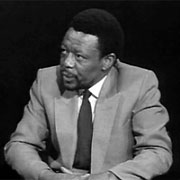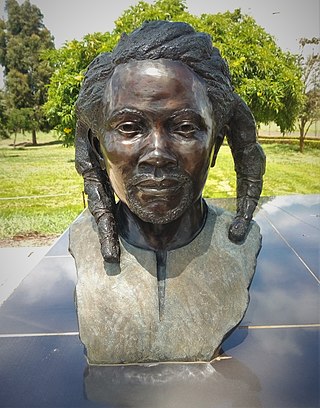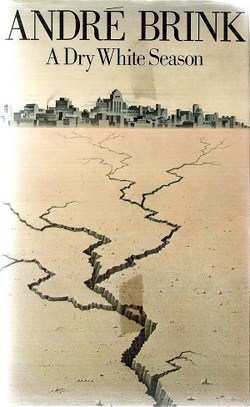Freedom Park is a park situated on Salvokop in Pretoria. It includes a memorial with a list of the names of those killed in the South African Wars, World War I, World War II as well as during the apartheid era. [1]
Contents




Freedom Park is a park situated on Salvokop in Pretoria. It includes a memorial with a list of the names of those killed in the South African Wars, World War I, World War II as well as during the apartheid era. [1]




Construction of the park occurred in various phases and was dealt with by Stefanutti Stocks, WBHO, Trencon, Concor and others. [2]
The Project was overseen in totality by Mongane Wally Serote. [3]
In March 2009, twenty-four deceased liberation struggle heroes were proposed for inclusion to the memorial. Some of the national leaders chosen include Steve Biko, Oliver Tambo, Helen Joseph, Albert Lutuli, and Bram Fischer.
International and continental leaders were also among those considered for their contribution to the liberation of South Africa or the repressed in general. The continental leaders included Mozambican President Samora Machel and Amílcar Cabral. Amongst the international list was Che Guevara, a revolutionary who fought alongside former Cuban President Fidel Castro, and Toussaint Louverture, who fought during Haiti's war for independence. [4]

Pretoria is South Africa's administrative capital, serving as the seat of the executive branch of government, and as the host to all foreign embassies to South Africa.

The Day of Reconciliation is a public holiday in South Africa held annually on 16 December. The holiday came into effect in 1995 after the end of apartheid, with the intention of fostering reconciliation and national unity for the country. The date was chosen because it was significant to both Afrikaner and black African cultures. The government chose a meaningful date for both ethnic groups because they recognised the need for racial harmony. The celebration of the Day of Reconciliation can take the form of remembering past history, recognising veteran's contributions, marching, and other festivities.

Mongane Wally Serote is a South African poet and writer. He became involved in political resistance to the apartheid government by joining the African National Congress (ANC) and in 1969 was arrested and detained for several months without trial. He subsequently spent years in exile, working in Botswana, and later London, England, for the ANC in their Arts and Culture Department, before eventually returning to South Africa in 1990. He was inaugurated as South Africa's National Poet Laureate in 2018.

The Pan Africanist Congress of Azania (known as the Pan Africanist Congress (PAC)) is a South African national liberation Pan-Africanist movement that is now a political party. It was founded by an Africanist group, led by Robert Sobukwe, that broke away from the African National Congress (ANC) in 1959, as the PAC objected to the ANC's "the land belongs to all who live in it both white and black" and also rejected a multiracialist worldview, instead advocating a South Africa based on African nationalism.

The Union Buildings form the official seat of the South African Government and also house the offices of the President of South Africa. The imposing buildings are located in Pretoria, atop Meintjieskop at the northern end of Arcadia, close to historic Church Square. The large gardens of the Buildings are nestled between Government Avenue, Vermeulen Street East, Church Street, the R104 and Blackwood Street. Fairview Avenue is a closed road through which only officials can enter the Union Buildings. Though not in the centre of Pretoria, the Union Buildings occupy the highest point of Pretoria, and constitute a South African national heritage site.

An eternal flame is a flame, lamp or torch that burns for an indefinite time. Most eternal flames are ignited and tended intentionally, but some are natural phenomena caused by natural gas leaks, peat fires and coal seam fires, all of which can be initially ignited by lightning, piezoelectricity or human activity, some of which have burned for hundreds or thousands of years.

Dedan Kimathi Waciuri, born Kimathi wa Waciuri in what was then British Kenya, was the senior military and spiritual leader of the Mau Mau Uprising. Widely regarded as a revolutionary leader, he led the armed military struggle against the British colonial regime in Kenya in the 1950s until his capture in 1956 and execution in 1957. Kimathi is credited with leading efforts to create formal military structures within the Mau Mau, and convening a war council in 1953. He, along with Baimungi M'marete, Musa Mwariama, General China and Muthoni Kirima, was one of the Field Marshals.
The following lists events that happened during 1975 in South Africa.
Atteridgeville is a township located to the west of Pretoria, South Africa. It is located to the east of Saulsville, to the west of West Park; to the north of Laudium and to the south of Lotus Gardens. The settlement was established in 1939, and is named after Mrs MP Atteridge, chairwoman of the Committee for Non-European Affairs on the Pretoria City Council at the time. The Lucas Masterpieces Moripe Stadium is located in Atteridgeville.
Herman Andimba Toivo ya Toivo was a Namibian anti-apartheid activist, politician and political prisoner. Ya Toivo was active in the pre-independence movement, and is one of the co-founders of the South West African People's Organisation (SWAPO) in 1960, and before that, its predecessor the Ovamboland People's Organization (OPO) in 1959.
Heroes' Day or National Heroes' Day may refer to a number of commemorations of national heroes in different countries and territories. It is often held on the birthday of a national hero or heroine, or the anniversary of their great deeds that made them heroes.
Jonas Mosa Gwangwa was a South African jazz musician, songwriter and producer. He was an important figure in South African jazz for over 40 years.

Thabang Sampson Makwetla MP is a South African politician affiliated with the African National Congress (ANC). He is a Member of the National Assembly of South Africa and is the current Deputy Minister of Defence and Military Veterans, a role he previously served in between 2009 and 2014. He has also served as the Deputy Minister of Justice and Correctional Services, and was Premier of Mpumalanga province between 2004 and 2009.
Frederick John Harris was a South African schoolteacher and anti-apartheid campaigner who turned to terrorism and was executed after a bomb attack on a railway station. He was Chairman of SANROC, which in 1964 petitioned the International Olympic Committee to have South Africa excluded from the Olympics for fielding a white-only team. After being arrested for his political activities, he became a member of the African Resistance Movement (ARM).

Molteno is a town in the Eastern Cape province of South Africa.
Omugulugwombashe is a settlement in the Tsandi electoral constituency in the Omusati Region of northern Namibia. The settlement features a clinic and a primary school. In 1966, the first battle of the South African Border War was fought in Omugulugwombashe. The government of Namibia erected a monument on the 30th anniversary of the battle in 1996.
The South African Literary Awards (SALA) have been awarded annually since 2005 to exceptional South African writers. They "pay tribute to South African writers who have distinguished themselves as ground-breaking producers and creators of literature" and celebrate "literary excellence in the depiction and sharing of South Africa’s histories, value systems, philosophies and art." The Awards are open to work in all of South Africa's eleven official languages, and they may include posthumous honours.

A Dry White Season is a fictional novel written by Afrikaner novelist André Brink and first published by Taurus in 1979. The title quotes a line from the struggle poem For Don M. - Banned by Mongane Wally Serote. The novel focuses on the death during detention of a man wrongly suspected of being a black activist. The novel challenges apartheid, depicting the transformation of a ruling class Afrikaner's opposition to the governing, white supremacist regime. The novel was initially banned in South Africa, though Brink had 3,000 copies published through an underground press.

Madagascar–South Africa relations refers to the diplomatic relations between Madagascar and South Africa. Both nations are members of the African Union, Group of 77, Non-Aligned Movement and the Southern African Development Community.

Medu Art Ensemble was a collective of cultural activists based in Gaborone, Botswana during the height of the anti-apartheid resistance movement during the late twentieth century. The collective formed originally in 1977 as a group of black South African artists mutually invested in regional liberation struggles and resistance to South Africa’s apartheid policy of racial segregation (1948-1994). Medu’s members, or “cultural workers” as they preferred to be called, eventually organized and relocated to Gaborone, Botswana in 1978. They felt that the term "cultural workers" was far more fitting to their mission rather than referring to themselves as artists because the such a pursuit was regarded as something trivial and therefore inherently elitist and white. With the support of the African National Congress (ANC), in Gaborone Medu officially registered as a cultural organization with the Botswanan government. Medu means “roots” in the Northern Sotho language, and so describes the collective's underground operations. The collective’s cultural work was rhizomatic in nature, stretching across seven semi-autonomous units: Film, Graphics, Music, Photography, Poetry, Publishing and Research, and Theatre.